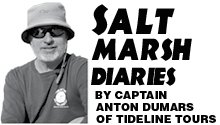After the rains stop, problems still persist
 Grace appeared in the bathroom mirror. She stood, wagging her tail and smiling. Grace, a small black lab mix with a white chin and chest, has been described as a “perma-puppy.” She and Zeke, an aging springer spaniel, spend their time interpreting my nuanced movements, and then adjust their actions accordingly. For example, when I’m seen with coffee in hand and a messenger bag slung over the shoulder, Zeke knows to go stand on the front porch in obstinacy. It’s his way of trying to keep me home.
Grace appeared in the bathroom mirror. She stood, wagging her tail and smiling. Grace, a small black lab mix with a white chin and chest, has been described as a “perma-puppy.” She and Zeke, an aging springer spaniel, spend their time interpreting my nuanced movements, and then adjust their actions accordingly. For example, when I’m seen with coffee in hand and a messenger bag slung over the shoulder, Zeke knows to go stand on the front porch in obstinacy. It’s his way of trying to keep me home.
I turned from the mirror toward Grace and said, “walk.” As she absorbed the word, her tail quit wagging and her mouth closed. Graced turned and trotted out of the room. A moment later, she returned to re-read my face, then hurried off toward the front door. Zeke caught the drift. Within moments, both dogs launched into full-blown pre-walk jumping, barking hysteria.
Beginning Friday, Oct. 2, Hurricane Joaquin directed a fire hose of rain onto South Carolina. The rained lasted for three solid days. On Saturday, because of all the rain, we decided to cut our Asheville visit short and drive back to Folly. By Sunday, floodwater along the route had closed roads. Once back to Folly, we found streets flooded everywhere. Ashley Avenue had become “Lake Ashley.” The neighbor’s downstairs garage flooded to near three feet. By the end, several houses on Folly flooded. Because of the flooding, Grace and Zeke had to wait a while for their next walk.
From a geologist’s perspective, I sat fascinated, monitoring real-time online hydrographs. Three piedmont rivers (the Black, the Santee, and the Edisto) were now in full flood and rising. A slug of water moved down each river toward the coast like a swallowed rat in a corn snake. On Monday, the sun came out, but for many who lived near these rivers, the worst was yet to happen. By mid-week, the perspective slugs each reached Kingstree and Givhans Ferry. Both areas flooded. On Folly, standing water persisted as groundwater emerged at low elevations into streets and yards.
Along the coast, higher than normal tides continued. Two weather systems, a high to the north and the hurricane offshore, created a meteorological egg-beater. Onshore winds produced a mini storm surge that drove extreme tides onshore for five days. These tides caused fair weather “nuisance” flooding of Lowcountry streets, many of which never normally flooded.
A week after the rain ended, the moat-like standing water in front of our house finally began to recede. Large puddles became small puddles. The word “walk” once again became commonplace at the DuMars residence.
Side note: On Oct. 27, as I sit writing this column, onshore winds had created an 8.69 tide. Tidal flooding again plagues Charleston County. Sunny day “nuisance” flooding in the Lowcountry has increased almost five-fold since 1957, from five days per year then to more than 23 days per year now. Draw your own conclusions …
Anton DuMars, owner of Tideline Tours, is a coastal geologist who enjoys a good graph. Come join him for a romp through the salt marsh! Visit: www.tidelinetours.com.

